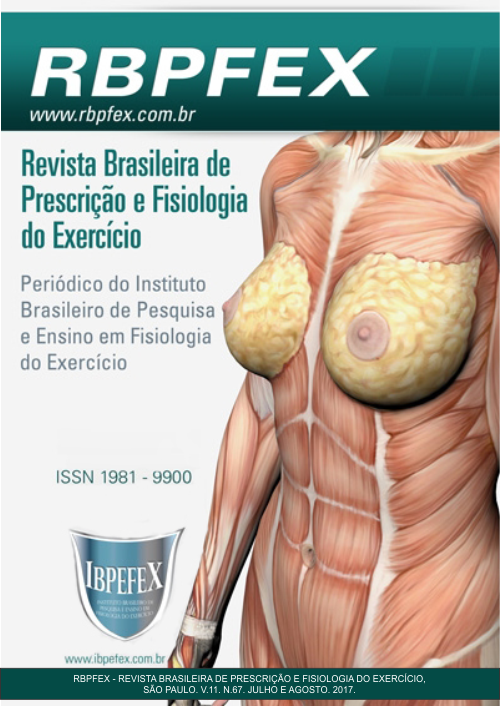Comparative of resisted training methodologies decreasingand traditional pyramidal in men: morfofunctional amendments
Abstract
The most well-known strength training methodology among bodybuilders is the traditional multi-series Traditional Method (TM). In addition to this method, it is common to use the Descending Pyramid (PD), which consists of decreasing the weight and increasing the repetitions after each series. Strength, muscle hypertrophy and fat percentage in untrained men. In the first week the anthropometric evaluations took place, and bioimpedance. In the second, training of familiarization of the exercises, being that in the same the groups were submitted to the test of 1 RM in the Supino and Leg Press, from the 3rd to the 14th week, the subjects were divided into 2 MT and PD groups. The MT group trained with 4 series of 12RM; and the PD group, 4 sets of 6, 8, 10 and 12RM, decreasing weight; And in the 15th week, reevaluation. Results: We observed in both groups the increase in strength, indicated by the 1RM test in the bench press and leg press. There was a significant difference between PD and MT (P = 0.044) in the supine test. There was no significant reduction in post-training fat percentage. Groups, with a significant difference (p = 0.024) between groups in arm circumference. Conclusion: The PD method obtained satisfactory results in untrained individuals, compared to the traditional method, in the test of maximum load in the bench press and arm circumference.
References
-ACSM. Position Stand on progression models in resistance training for health adults. Medicine and Science in Sports and Exercise. Vol. 34. p. 364-380. 2002.
-Arruda, D.P. Relação entre treinamento de força e redução do peso corporal. Revista Brasileira de Prescrição e Fisiologia do Exercício. Vol. 4. Núm. 24. p. 605-609. 2010. Disponível em: <http://www.rbpfex.com.br/index.php/rbpfex/article/view/291/293>
-Brown, L.E.; Weir,J.P. ASEP Procedures recommendation I: accurate assessment of muscular strength and power. Journal of Exercise Physiology online. Vol. 4. Núm. 3. p. 1-21. 2001.
-Buchman, J.R.; Costa E.E.L.M.; Szott, A.; Castilhos, G.G.; Navarro, A.C. Comparação das alterações das variáveis fisiológicas agudas através do método tradicional e pirâmide para hipertrofia. Revista Brasileira de Prescrição e Fisiologia do Exercício. Vol. 2. Núm.10. p. 400-408. 2008. Disponível em: <http://www.rbpfex.com.br/index.php/rbpfex/article/view/100/104>
-Ceola, M.H.J.; Tumelero, S. Grau de hipertrofia muscular em resposta a três métodos de treinamento de força muscular. Revista Digital EFDeportes.com. Núm. 121. 2008.
-Costa, R.F. Composição corporal. Teoria e prática da avaliação. Manole. 2001.
-Fleck, S.J.; Kraemer, W.J. Fundamentos do Treinamento de Força Muscular. 3.ed. Porto Alegre: Artmed. 2006.
-Manzini Filho, M.L.; Costa, S.P.; Rodrigues, B.M.; Matos, D.G.; Moreira, C.M.R.; Moreira, O.C.; Aidar, F.J. Comparação dos métodos pirâmide crescente e decrescente no aumento da força muscular. Revista Brasileira de Prescrição e Fisiologia do Exercício. Vol. 9. Núm. 53. p. 240-249. 2015. Disponível em: <http://www.rbpfex.com.br/index.php/rbpfex/article/view/734/696>
-Materko, W.; Duarte, M.; Santos, E.L.; Junior, H.S. Comparação entre dois sistemas de treino de força no desenvolvimento da força muscular máxima. Motricidade. Vol. 6. Núm. 2.p. 5-13. 2010.
-Okano, A.H.; Cyrino, E.S.; Nakamura, F.Y.; Guariglia, D.A.; Nascimento, M.A.; Avelar, A.; Moraes, A.C. Comportamento da força muscular e da área muscular do braço durante 24 semanas de treinamento com pesos. Revista Brasileira de Cineantropometria e Desempenho Humano. Vol. 10. Núm. 4. p. 379-385. 2008.
-Ploutz-Snyder, L.; Giamis, E. L. Orientation and familiarization to 1RM strength testing in young and old women. Journal of strength and conditioning research. Vol. 15. Núm. 4. p. 519-523. 2001.
-Salles, B.F.; Silva, J.P.M.; Oliveira, D.; Ribeiro, F.M.; Simão, R. Efeito dos métodos pirâmide crescente e pirâmide decrescente no número de repetições do treinamento de força. Arquivos em movimento. Vol. 4. Núm. 1. p. 23-32. 2008.
-Silva, D. P.; Curty, V.M.; Áreas, J.M.; Souza, S.C.; Libaino, G.A. Resposta crônica da pressão arterial sistólica em diferentes métodos de treinamento de força: Delorme versus Oxford. Perspectivas Online. Vol. 3. Núm. 12. p. 197-204. 2009.
-Tanita Corporation. Tanita Body Fat Monitor/Scale Model: UM-080. Instruction Manual. p. 6. 2005.
-Uchida, M. C.; Aoki, M.S.; Navarro, F.; Tessuti, V.D.; Bacurau, R.F.P. Efeito de diferentes protocolos de treinamento de força sobre parâmetros morfofuncionais, hormonais e imunológicos. Revista Brasileira de Medicina do Esporte. Vol. 12. Núm. 1.p. 21-26. 2006.
-World Health Organization. Physical status: the use and interpretation of anthropometry. Geneva. WHO. 1995.
Authors who publish in this journal agree to the following terms:
- Authors retain the copyright and grant the journal the right of first publication, with work simultaneously licensed under the Creative Commons Attribution License BY-NC which allows the sharing of the work with acknowledgment of the authorship of the work and initial publication in this journal.
- Authors are authorized to enter into additional contracts separately for non-exclusive distribution of the version of the work published in this journal (eg, publishing in institutional repository or book chapter), with acknowledgment of authorship and initial publication in this journal.
- Authors are allowed and encouraged to post and distribute their work online (eg, in institutional repositories or on their personal page) at any point before or during the editorial process, as this can bring about productive change as well as increase impact and impact. citation of published work (See The Effect of Free Access).






